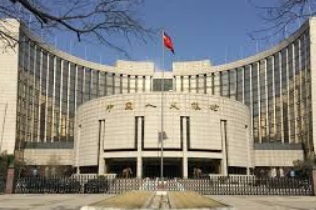New Year, New Dilemma
China's PBOC gradually returns to the headlines as it's gripped by the increasingly complex task of defending a weakening currency without sending already rising yields higher. Why is this a dilemma? CNY fell to 5-year lows due to surging capital outflows resulting from Chinese companies, speculators and investors taking money abroad and/or placing it in higher-yielding and returning US dollar-denominated paper. In order to support the yuan, the PBOC depleted its foreign currency reserves by 23% in 2016 as it sold USD, JPY and other FX to buy CNY, hoping to contain the exodus of capital. The most conventional way to do that is by draining liquidity from the bond market so as to make its currency more valuable – yet at the expense of driving already rising bond yields even higher. Less liquidity means rising interest rates.
How far have China's yields gone? The yield on Chinese 10-year govt bonds hit 3.30% last week, reaching its highest since August 2015, the very month China's stock market crashed and shook global equities along with it. Chinese short term bonds also felt the strain as the overnight SHIBOR (the rate charged among Chinese banks to hold liquidity overnight) hit 21-month highs, reflecting the elevated difficulty facing banks to obtain and finance short-term loans. As bond yields rise (also due to rising Chinese CPI and higher global yields), their prices fall, highlighting the risk to China's household investors, who have plunged nearly $4 trillion in yield-chasing instruments. These Wealth Management Products make up about 35% of China's GDP and are … not guaranteed by the banks offering them. Surely, you will be hearing about them from me again as the year progresses.
PBOC Steps in
Add to all of this Fed hike expectations and downward pressure on CNY, you will surely hear more about China's jittery bond market as yields push higher. And so, aside from the problem of a falling currency, the central bank now has to solve the challenge of rising bond yields by continuing to inject massive amounts of liquidity, which goes against the solution of stabilizing its currency.How do I step in?
Playing the “China Trade” in currencies can be done via AUD and/or USD. But how does one deal with the inevitable rumblings about rapid USD strength and/or overheating Aussie housing market? Is there a preferred tactic to play China, without riding an already-run-away train? My latest Premium Video tackles 5 new trading ideas suitable for this development, as well as other technical considerations, which have developed over the last 2 weeks.Wishing you a Happy & Healthy New Year
Latest IMTs
-
5 Stocks Worked for me Best in 2025
by Ashraf Laidi | Dec 5, 2025 14:42
-
Silver 150 Highly Plausible
by Ashraf Laidi | Dec 4, 2025 11:19
-
4264 Gold
by Ashraf Laidi | Dec 2, 2025 13:56
-
Bitcoin & 35 Pct
by Ashraf Laidi | Dec 1, 2025 11:10
-
Forecaster App التطبيق الذي كنت تنتظره
by Ashraf Laidi | Nov 30, 2025 9:55








